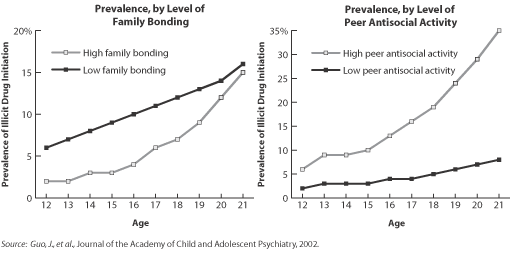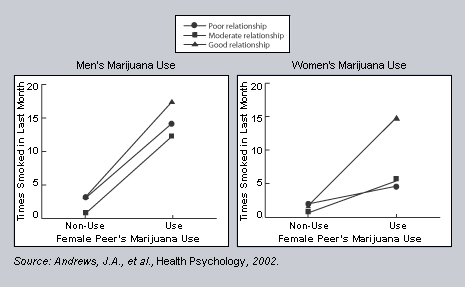The influence of family and peers on adolescent substance abuse has been well documented in the scientific literature. Generally, positive family influences, such as family bonding and consistent rules, appear to reduce the risk of tobacco, marijuana, and other drug abuse among teens, while negative family influences tend to increase risk. The same is true of positive and negative peer factors. Little research, however, has been conducted to see how parental and peer factors interact to influence adolescents' initiation to and young adults' use of drugs.
Two new NIDA-funded studies--one looking at initiation of substance use, the other at continued substance abuse--show that some aspects of family and peer influences remain potent from early initiation into young adulthood and across socioeconomic, ethnic, and gender lines. Both studies yielded surprises and implications for intervention. For example, the first study found that although family and peer factors had similar effects on males and females, family monitoring and rules had a stronger protective effect for males than females. The second study found that for either gender, peer influence was not mediated by the quality of the relationship, except for female peer influence on young adult marijuana use.
Impact of Family on Teens' Initiation to Drugs
University of Washington researchers recruited 808 5th-graders from 18 Seattle elementary schools in high-crime areas and followed them from ages 12 to 21 to see how peer, family, and sociodemographic factors interacted to influence drug initiation.
As part of an ongoing NIDA study directed by Dr. J. David Hawkins, data from this group were gathered annually through age 16 and again at 18 and 21. The sample included a high proportion of low-income families, "but not all children came from homes in high-risk neighborhoods," says Dr. Karl Hill, one of the study's authors. Of concern were the extent of bonding to family, family involvement (time spent interacting with parents), family conflict resolution and parenting practices (monitoring, rules, and consistent discipline), peers' prosocial and antisocial activities, and measures of use for tobacco, marijuana, cocaine, amphetamines, tranquilizers, sedatives, and psychedelics.
Initiation of illicit drug use for the entire study group was 4.6 percent by age 12, 8.4 percent by age 13, 12.6 percent by age 18, and 40.5 percent by age 21. By age 21, 45.4 percent of male participants had initiated illicit drug use, as had 35.5 percent of females. Native Americans had the highest rate of initiation, at 55.9 percent, compared to 53.6 percent of European Americans, 33.3 percent of African Americans, and 14.6 percent of Asian Americans.
All of the measured family factors were influential, with the terms low level referring to families in the lowest 10 percent for a specific factor and high level referring to those in the highest 10 percent. Higher levels of family monitoring and rules were associated with a "significantly" lower risk of illicit drug initiation, according to Dr. Hill. For example, youths with low levels of family monitoring and rules at age 18 were twice as likely (14 percent versus 7 percent) to initiate illicit drugs as those with high family monitoring. The same was true for a higher level of moderate and consistent family discipline--youths with low consistent family discipline were over twice as likely (15 percent versus 6 percent) at age 18 to initiate illicit drugs as those with high consistent family discipline.
 Family Bonding and Peer Antisocial Activity Impact Drug Initiation Among Adolescents. Low levels of family bonding and high levels of peer antisocial activity were consistently associated with higher prevalence of illicit drug initiation among youths ages 12 to 21 compared with prevalence seen when high levels of family bonding and low levels of peer antisocial activity were present. By age 21, however, a high level of family bonding had far less impact than in earlier years on adolescent drug initiation.
Family Bonding and Peer Antisocial Activity Impact Drug Initiation Among Adolescents. Low levels of family bonding and high levels of peer antisocial activity were consistently associated with higher prevalence of illicit drug initiation among youths ages 12 to 21 compared with prevalence seen when high levels of family bonding and low levels of peer antisocial activity were present. By age 21, however, a high level of family bonding had far less impact than in earlier years on adolescent drug initiation.Family bonding was particularly influential before the age of 18--youths with low family bonding at age 15 were three times more likely (9 percent versus 3 percent) to initiate illicit drugs than those with high family bonding. Higher levels of family conflict were associated with a higher risk of initiation. For example, youths with high family conflict at age 18 were over twice as likely (15 percent versus 6 percent) to initiate illicit drugs as those with low family conflict. High levels of peer antisocial activity, especially after age 15, found youths at age 18 nearly four times as likely (19 percent versus 5 percent) to initiate illicit drugs as those with low antisocial peer influence (in the bottom 10 percent).
Family monitoring and rules seemed to reduce the risk of initiation primarily by affecting the child's choice of peer groups. "Some family factors operate through peers and some are independent of peer groups," Dr. Hill explains. "Kids with low bonding to parents are more likely to get involved with narcotics and stimulants, even if they don't hang out with bad peers. So you end up with this set of independent risks with high family conflict, low bonding, and bad peer involvement. All these things stack the deck toward initiation of serious drug use.
"In general, family and peer factors had similar effects on boys and girls," Dr. Hill observes. "Only family monitoring and rules had a stronger protective effect for males than for females." Family monitoring and bonding were more predictive for European Americans than for African Americans. Otherwise, says Dr. Hill, "family and peer factors affecting illicit drug initiation were similar across gender and ethnic groups."
The message is clear: Family factors matter. "The impact of only one factor--family bonding--begins to decline after age 18," Dr. Hill says. Peer factors also matter. Having antisocial peers, especially after age 15, increases the risk of drug initiation. "Both sets of influences contribute," he says, "even after controlling for sociodemographic background and prior alcohol, tobacco, and marijuana initiation."
In terms of intervention, "family and peer factors should be important targets for preventive efforts," Dr. Hill says. The effort should start early and continue into the twenties, emphasizing family bonding early and family monitoring, rules, and reduction of conflict throughout. "Programs that address these family and peer factors should work relatively well across gender and ethnic groups," he concludes.
Influence of Peers on Young Adults' Substance Abuse
Another NIDA-funded study took a slightly different path, looking at peer influence on young adults. As part of a long-range study led by Dr. Hyman Hops of the Oregon Research Institute in Eugene, Oregon, the researchers gathered data from 294 participants ages 19 to 25. Each participant brought one same-sex and one opposite-sex peer into the study; those who were married brought their marital partner as their opposite-sex peer. Data gathered annually for 3 years included the quality of these relationships, the extent of any substance abuse, and the problems associated with drug use.
At the beginning of the study, 30 percent of the 294 participants had smoked cigarettes, 29 percent had smoked marijuana in the previous month, 10 percent had used other illicit drugs, and 41 percent reported problems associated with drug use in the previous 12 months. Thirty-nine percent had not used any drugs in the period specified. Men who smoked marijuana did so, on average, more often than female marijuana smokers did--an average of 5.5 times per month versus women's average of 2.7 times a month. "Other differences between genders were not significant," says Dr. Judy Andrews, lead author of the Oregon team. "Correlations between various substances were moderate."
 Quality of Female Peer Relationship Impacts Young Adult Marijuana Use. Each participant brought one same-sex and one opposite-sex peer into this study; participants who were married brought their spouse as their opposite-sex peer. The quality of the relationship with a female peer was a factor in young adults' marijuana use; with young adults' use of other substances, however, the quality of the peer relationship was not a factor.
Quality of Female Peer Relationship Impacts Young Adult Marijuana Use. Each participant brought one same-sex and one opposite-sex peer into this study; participants who were married brought their spouse as their opposite-sex peer. The quality of the relationship with a female peer was a factor in young adults' marijuana use; with young adults' use of other substances, however, the quality of the peer relationship was not a factor.Use of drugs by male peers positively influenced subsequent use by both men and women. "I expected females, in general, to be more influenced by males than by females," Dr. Andrews says, "and we found that to be true only in cases where the user reported problems associated with drug use. For example, friends of both genders also influenced both males' and females' subsequent cigarette smoking."
Another surprise emerged in the effect of good versus bad peer relationships. In general, the quality of the relationship with the friend did not matter when it came to substance use. "We expected that peer influence would be mediated by the quality of that relationship," explains Dr. Andrews. "If you don't like some, why would you emulate him or her? But we found this effect only with marijuana use when the peer was female. Good female friends influenced the marijuana use of both males and females. But if the good friend was male, he did not influence the marijuana use of either his male or female friend."
Again, the overall message is clear: Young adults are influenced by their friends. "It's an important finding," observes Dr. Andrews. "Interventions with substance-abusing young adults should not only be with individuals, but with their peers as well."
"We are continuing to see family and peer effects into early adulthood," says Dr. Kathleen Etz of NIDA's Division of Epidemiology, Services and Prevention Research. "People assume that families become less important as kids move out of the house, and this does not appear to be the case.
"Many of our interventions target adolescents and very few target young adults. Given that in the Oregon Research Institute study marijuana use was initiated after high school, it's clear that we have to look more carefully at interventions for young adulthood."
Sources
- Andrews, J.A.; Tildesley, E.; Hops, H.; and Li, F. The influence of peers on young adult substance use. Health Psychology 21(4):349-357, 2002. [Full Text]
- Guo, J.; Hill, K.G.; et al. A developmental analysis of sociodemographic, family, and peer effects on adolescent illicit drug initiation. Journal of the Academy of Child and Adolescent Psychiatry 41(7):838-845, 2002.
